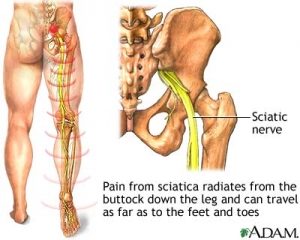
Sciatica
 You know what it feels like: shooting pain down your leg. You might also have tingling or numbness.
You know what it feels like: shooting pain down your leg. You might also have tingling or numbness.
Your doctor says it’s sciatica, but confusingly enough, sciatica isn’t actually a condition.
It’s a medical term used to describe symptoms-the shooting pain, tingling, and numbness-caused by a low back condition.
That means that your sciatica could be caused by a bulging disc or a herniated disc, degenerative disc disease, piriformis syndrome, pregnancy, spinal stenosis, a spinal tumor or spinal infection, spondylolisthesis, or trauma.
Any one of those conditions can put pressure on the sciatic nerve or related nerve roots in your low back. And that pressure is what causes your pain and other symptoms.
Your doctor may also call sciatica a radiculopathy, which is a medical term used to describe pain, numbness, tingling, and weakness in the arms or legs.
Since sciatica originates in your low back-the lumbar spine-it is called a lumbar radiculopathy.

Anatomy of Sciatica
The sciatic nerve is the longest and largest nerve in your body. Five sets of paired nerve roots combine to create it, and it’s about the diameter of a finger.
The sciatic nerve starts in your low back, which is called your lumbar spine. The nerve roots are at the L4 and L5 vertebrae (the ‘L’ means lumbar, and the numbers indicate the level of the vertebra-where it is in your back). The sciatic nerve also travels through your pelvic region (sacrum).





